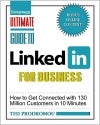Starting a LinkedIn Group to Grow Your Network How to create a focused, topic-driven community and better connect to clients and customers.
Opinions expressed by Entrepreneur contributors are their own.

In his book Ultimate Guide to LinkedIn for Business, author Ted Prodromou describes how to best to leverage the networking site as a business tool. In this edited excerpt, the author details how to start and manage groups, a smart way to grow your online community.
LinkedIn Groups are an easy way for you to start an online community for your company. If you already have a lot of customers and prospects who are LinkedIn members, starting a LinkedIn Group for them is a smart thing to do.
Before you start your own group, you need to determine if you are willing to make the time commitment to make the group a success. Starting a group is easy, but growing it and keeping it active can take a lot of work, especially in the beginning. I highly recommend you create a team of people who can share in the management and promotion of your group.
The topics you choose to be the focus of group discussions will determine your group's appeal. Research topics within your niche that generate interest and choose the top two or three as the basis for your group.
When you start a new group you will need to fill out a profile that includes a description of the group, which includes keywords that will help to generate interest. Look at some popular LinkedIn groups and see how they worded their descriptions.
LinkedIn offers many options for configuring how your group will function in the "group settings" section under "manage." It's important to consider all of these when configuring the "group settings."
Make sure to check the "enable the discussions" box and "news features," which is on by default. You have the option to conduct group polls and display promotions and jobs, and to allow your group members to do the same. I recommend only allowing moderators and managers to use these functions until you get to know the group members.
Related: Creating Your Company's LinkedIn Profile
You can also temporarily moderate new group members, new LinkedIn members and members with few or no connections who are usually spammers.
If someone is new to LinkedIn or has few or no LinkedIn connections, I wouldn't approve their membership because they wouldn't be able to provide much value. Once they become established on LinkedIn, they will understand how groups work and be able to contribute. The only time I would admit a new LinkedIn member is if I knew the person, or someone I trusted recommended them.
You have two membership options with your group. You can automatically approve all members if you want your group open to everyone, or you can keep your group closed so everyone needs to be approved.
From my experience, open groups that serve large audiences can become unfocused if the moderator doesn't participate actively. A good group manager can keep the group focused on a topic by starting new discussions, featuring popular, relevant discussions and privately contacting members who are posting discussions that are off-topic. It also helps to have multiple moderators for a large, open group.
Related: 5 Underutilized LinkedIn Marketing Tools
The discussions in product-related communities are amazingly focused and on-topic. You don't see many people asking questions about other Adobe products or competitors' products in the Photoshop communities because the members are knowledgeable enough to keep the discussions focused. If someone starts a discussion that isn't relevant, a group member or moderator will often suggest a better place to post that question. These communities are often self-policing and self-supporting, which makes the community much stronger and more vibrant.
Closed groups generally will be smaller and more focused, since every member is manually approved by the group manager or moderator. You usually don't have as many new discussions or comments, but the discussions are very focused. You also have a small community of experts who are very knowledgeable about specific products or topics.
There are a lot of factors that come into play when deciding how to structure your group, and it's imperative that you have a plan and a goal before you begin. Your reputation is on the line when you create a group. Identify your purpose, allocate resources and create a detailed plan so that your group will thrive and provide value to your company.
Once you've seeded the group with some stimulating conversations, you can start promoting the group to your network and through social media. The best way to invite others to join your group is by sending an invitation with a personal message to let them know who you are and why you want them to join the group.
You can encourage members to invite their friends to join, if they use personalized messages. You will then be able to approve or decline new invitations as you see fit. If you want to grow your group quickly, you can start promoting it via social media and also run ads on LinkedIn.
Related: 3 Simple Ways to Use LinkedIn to Boost Sales
This article is an excerpt from Ultimate Guide to LinkedIn for Business available from Entrepreneur Press.











